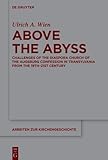Above the Abyss : Challenges of the Diaspora Church of the Augsburg Confession in Transylvania from the 19th–21st Century / Ulrich A. Wien.
Material type: TextSeries: Arbeiten zur Kirchengeschichte ; 161Publisher: Berlin ; Boston : De Gruyter, [2024]Copyright date: 2024Description: 1 online resource (XII, 628 p.)Content type:
TextSeries: Arbeiten zur Kirchengeschichte ; 161Publisher: Berlin ; Boston : De Gruyter, [2024]Copyright date: 2024Description: 1 online resource (XII, 628 p.)Content type: - 9783111372167
- 9783111373577
- 9783111373300
- 284.1/4984 23/eng/20240502
- BX8025.7 .W54 2024
- online - DeGruyter
- Issued also in print.
| Item type | Current library | Call number | URL | Status | Notes | Barcode | |
|---|---|---|---|---|---|---|---|
 eBook
eBook
|
Biblioteca "Angelicum" Pont. Univ. S.Tommaso d'Aquino Nuvola online | online - DeGruyter (Browse shelf(Opens below)) | Online access | Not for loan (Accesso limitato) | Accesso per gli utenti autorizzati / Access for authorized users | (dgr)9783111373300 |
Frontmatter -- Acknowledgements -- Contents -- Introduction – A short Historical Overview -- 1 From the “Folk-Church” to the “Folk-Religion”? Observations Concerning the Developments of the Evangelical Landeskirche A. C. in Romania Between 1919 and 1944 -- 2 Ethnic Cohesion in Terms of Religion, Politics, Economics, Culture and Historiography. The Middle Clergy of the Church of the Augsburg Confession in Transylvania (1850–1918) -- 3 “Discernment and Not Just Note Taking” – On the Meaning of the European Cultural and Scholarly Networking in the Life of Dr. Adolf Schullerus (1864–1928), Transylvanian-Saxon Pedagogue, Polymath, Vice-Bishop and Politician, Using the Correspondence Sent to him -- 4 The Evangelical Landeskirche A. C. in the Transylvanian Regions of Hungary During the First World War -- 5 The Beginnings of Pastoral Care for Those in the Diaspora of the Evangelical Transylvanian-Saxons at Home and Abroad: A Preamble to the Diary of the Fund-raising Trip to the USA in 1920 -- 6 The Development of National Consciousness and Ethnic Identity in South-Eastern Europe: The Example of the Carpathian Basin -- 7 The Evangelical Landeskirche A. C. in Transylvania Facing the Challenges of United Romania After 1918 -- 8 “Keep Guard Saxons!” or “Home in the Reich”? Challenges in the Congregations and Ecclesial District of Bucharest (Romania) in the Inter- War Period -- 9 Apologetics against Nationalsocialism in the “Spirit of the Samaritan” – Sermon from Viktor Glondys in 1931 -- 10 Christian Theology in Opposition to National Socialism? The Relationship Between Church and Politics in the Understanding of Bishop Dr. Viktor Glondys -- 11 The Ban on Radical Nazi Pastors and Employees of the Evangelical Landeskirche A. C. in Romania in 1936/1937. The Process against Wilhelm Staedel held by the Regional and High Church Disciplinary Court -- 12 On the “Concordat” Between the Volksgemeinschaft and the Evangelical Landeskirche A. C. in Romania. The Significance of the Agreement From 14 January 1936 Using the Example of the Youth Organization -- 13 The Fight for the Hearts and Minds of the Youth in the Evangelical Landeskirche A. C. in Romania (1933–1938) -- 14 Theology in Conflict – Protest in the Evangelical Landeskirche A.C. in Romania against Anti-Semitism in 1943 -- 15 The School Policy of the Church-Leadership in Hermannstadt and Temeswar for the German Minority Between 1919 and 1944. A Trans- Regional and Trans-Confessional Depiction -- 16 Diaconal work within Romania: Charity practiced by Protestant Sister-Communities in the 19th and 20th Centuries -- 17 Protestant Solidarity with Diaspora Churches: The Partnership with the Gustav-Adolf-Verein / Gustav-Adolf-Werk -- 18 The Evangelical Landeskirche A. C. in Romania from 1918 onwards: A Summary -- Abbreviations -- Glossary -- List of Figures -- Bibliography -- Register of Persons -- Geographical Register
restricted access online access with authorization star
http://purl.org/coar/access_right/c_16ec
The book focuses on the threat to free self-development and the effort to ward off a perceived threat of extinction as well as the development of self-preservation forces. The challenges for ethnic and religious minorities in the 19th–21st centuries are explained and unfolded against the historical background that serves as a frame of reference. The royal privileges granted in medieval Hungary were abolished in the mid-19th century. The German-speaking people’s church (Saxones) in Transylvania founded on this had to reorient itself, although a pioneer region of religious freedom had established itself behind the “Ottoman Curtain”. Since the reception of the Reformation, the “Saxones” had been Protestant. At the end of the 19th century, after the Austro-Hungarian Compromise, this minority realised the concept of cultural Protestantism in its purest form: ethnicity and religion were understood to be congruent. Homogeneity of society was the ideal, and affiliation with the German Empire was intensified. Economy, science, culture, language as well as school and church were understood as a unity; segregation and emigration were frowned upon. This concept fell into crisis due to various developments, including economic ones – especially after the annexation of Romania in 1918. National Socialism was widely adopted, along with anti-Semitism. For exponents of the church leadership, the Confessio Augustana only served as a label. On the one hand, external pressure under communist rule brought about a (only conditionally possible) retraditionalisation, on the other hand, it led to the bleeding out of the congregations due to increased emigration. Free development has only started again since the political upheaval in 1989. The church, which has become small, conveys important impulses and serves as a bridge to ecumenism.
Issued also in print.
Mode of access: Internet via World Wide Web.
In English.
Description based on online resource; title from PDF title page (publisher's Web site, viewed 20. Nov 2024)


